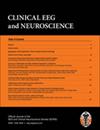精神分裂症患者白质微结构与智力下降的相关性研究。
IF 1.7
4区 医学
Q3 CLINICAL NEUROLOGY
Clinical EEG and Neuroscience
Pub Date : 2023-11-01
Epub Date: 2021-12-10
DOI:10.1177/15500594211063314
引用次数: 3
摘要
精神分裂症患者可能表现出智力下降,这是认知障碍的一个重要因素。先前的磁共振成像(MRI)研究表明,精神分裂症患者改变了与智力下降相关的灰质结构和功能连接,智力下降是由患病前和当前智力商(IQ)之间的差异定义的。然而,目前尚不清楚白质微观结构是否与智力下降有关。在本研究中,对138名精神分裂症患者和554名健康对照者的弥散张量成像(DTI)指标进行了分析。根据智力下降将患者分为三个亚组:恶化组(94名患者)、保留组(42名患者)和智商受损组(2名患者)。考虑到每个受试者的DTI是使用两种不同MRI扫描仪中的任何一种获得的,我们分别分析了每个扫描仪组的DTI指数。在智商下降组和健康对照组之间的比较中,无论MRI扫描仪如何,在三个感兴趣的区域中都注意到一些DTI指数的差异,而在智商保持组和健康控制组之间只注意到一个感兴趣区域的差异。然而,智商下降组和智商保持组之间的比较没有显示出任何可重复的差异。结合之前的研究结果,人们认为灰质结构和功能连接比白质微观结构更有希望作为精神分裂症智力下降的标志。本文章由计算机程序翻译,如有差异,请以英文原文为准。
Association Study Between White Matter Microstructure and Intelligence Decline in Schizophrenia.
Patients with schizophrenia can exhibit intelligence decline, which is an important element of cognitive impairment. Previous magnetic resonance imaging (MRI) studies have demonstrated that patients with schizophrenia have altered gray matter structures and functional connectivity associated with intelligence decline defined by a difference between premorbid and current intelligence quotients (IQs). However, it has remained unclear whether white matter microstructures are related to intelligence decline. In the present study, the indices of diffusion tensor imaging (DTI) obtained from 138 patients with schizophrenia and 554 healthy controls were analyzed. The patients were classified into three subgroups based on intelligence decline: deteriorated (94 patients), preserved (42 patients), and compromised IQ (2 patients) groups. Given that the DTI of each subject was acquired using either one of two different MRI scanners, we analyzed DTI indices separately for each scanner group. In the comparison between the deteriorated IQ group and the healthy controls, differences in some DTI indices were noted in three regions of interest irrespective of the MRI scanners, whereas differences in only one region of interest were noted between the preserved IQ group and the healthy controls. However, the comparisons between the deteriorated and preserved IQ groups did not show any reproducible differences. Together with the previous findings, it is thought that gray matter structures and functional connectivity are more promising as markers of intelligence decline in schizophrenia than white matter microstructures.
求助全文
通过发布文献求助,成功后即可免费获取论文全文。
去求助
来源期刊

Clinical EEG and Neuroscience
医学-临床神经学
CiteScore
5.20
自引率
5.00%
发文量
66
审稿时长
>12 weeks
期刊介绍:
Clinical EEG and Neuroscience conveys clinically relevant research and development in electroencephalography and neuroscience. Original articles on any aspect of clinical neurophysiology or related work in allied fields are invited for publication.
 求助内容:
求助内容: 应助结果提醒方式:
应助结果提醒方式:


